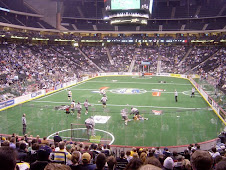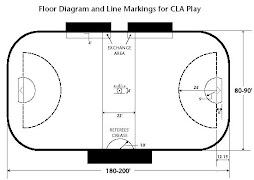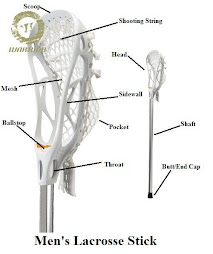- Wikipedia, December 10,2008 http://en.wikipedia.org/wiki/Box_lacrosse
- Google, December 10, 2008 http://www.google.ca/
- Google, December 12,2008 http://images.google.ca/images
- December 13, 2008 gbv=2&hl=en&sa=X&oi=spell&resnum=0&ct=result&cd=1&q=box+lacrosse&spell=1

Thursday, December 11, 2008
Works cited
Wednesday, December 10, 2008
General Facts
- 6 players for each team, at a time.
- The game starts with a faceoffs between two players (one from each team), the ball is placed between the backs of their stticks. They "fight" with each other to get the ball either below or in their stick and then ass it off to one of their teamates.
- Teams may sub players on and off whenever they feels like it unless a penalty has been called.
- Played on an ice rink after the ice has been removed or covered.
- The objective of the sport is to pass, carry and/or shoot/bounce the solid rubber ball into the opposing teams net.
- Only 8 nations have ever competed in the International box Lacrosse competition. Canada, Iroquois Nationals and the US have finished in the top 3 places.
Penalties and general officiating
For most penalties, the offending player is sent to the penalty box and his team has to play without him and with one less player for a short amount of time. Most penalties last for two minutes unless a major penalty has been assessed. The team that has taken the penalty is said to be playing shorthanded while the other team is on the power play. A two-minute minor penalty is often called for lesser infractions such as tripping, elbowing, roughing, too many players, illegal equipment, holding, or interference. Five-minute major penalties are called for especially violent instances of most minor infractions that result in intentional injury to an opponent, as well as for fighting. Players are released from the penalty box when either the penalty time expires, or the opposition scores a goal (or two goals for the instance of a major penalty).
At the officials' discretion a ten-minute misconduct penalty may be assessed. These are served in full by the penalized player, but his team may immediately substitute another player on the playing area unless a minor or major penalty is assessed in conjunction with the misconduct (a "two-and-ten" or "five-and-ten"). In that case, the team designates another player to serve the minor or major; both players go to the penalty box, but only the designee may not be replaced, and he is released upon the expiration of the two or five minutes. In addition, game misconducts are assessed for deliberate intent to inflict severe injury on an opponent. A player who receives a game misconduct is ejected and may not return to play. Receiving two major penalties in a game will result in a game misconduct.
A penalty shot, where a player from the non-offending team is given an attempt to score a goal without opposition from any defending players except the goaltender, may be awarded under certain circumstances. By rule, teams must have at least three runners in play. If a team commits a third penalty resulting in a "three man down" situation a penalty shot is awarded in favor of having the offending player serve in the penalty box. A penalty shot may also be awarded, at the referee's discretion, if a defensive player causes a foul to prevent a goal (by throwing his stick, holding, tripping, or by deliberately displacing the goal, or a defensive player intentionally falls and covers a ball in his own team's crease).
Fighting
Similar to fighting in ice hockey, fighting is illegal in box lacrosse. However, what separates box lacrosse and ice hockey from other sports is that at the top levels of professional and junior lacrosse, a five-minute major penalty is given and the players are not ejected for participating in a fight.
Fighting in youth or club level box lacrosse is typically penalized with expulsion and suspensions. In 1990, when the Six Nations created the new Mohawk lacrosse league, fighting was specifically targeted as unacceptable. Violators were ejected from the game in which the altercation occurred and given a minimum three game suspension.
Duration and tie-breaking methods
A traditional game played under the rules of the Canadian Lacrosse Association consists of three periods of 20 minutes each (similar to ice hockey), with the teams changing ends each period. The National Lacrosse League plays four 15-minute quarters rather than three periods. If the game is tied at the end of regulation play, overtime can be played. Overtime may or may not be sudden victory, depending on the league.
Ball in and out of play
Each period, and after each goal scored, play is restarted with a face-off. If a ball travels over the boards and outside of the playing area, play is restarted by possession being awarded to opposing team to that which last touched the ball.
During play, teams may substitute players in and out freely. Sometimes this is referred to as "on the fly" substitution. Substitution must occur within the designated exchange area in front of the players bench in order to be legal. The sport utilizes a shot clock and the attacking team must take a shot on goal within 30 seconds of gaining possession of the ball. In additional, players must advance the ball from their own defensive end to the offensive half of the floor within 10 seconds.
Playing Area
The playing area of box lacrosse is typically a ice hockey rink during the summer months. The playing surface is usually the concrete floor underneath the melted ice. Generally the playing area is 180 feet (55 m) to 200 feet (61 m) in length and 80 feet (24 m) to 90 feet (27 m) in width. The National Lacrosse League plays on artificial turf placed on top of the ice. Some leagues, and teams that have dedicated box lacrosse arenas (such as the Iroquois), have outfitted their playing surface with artificial turf similar to the National Lacrosse League.
Box lacrosse goals are dimensions are traditionally 4 feet (1.2 m) wide by 4 feet (1.2 m) tall. In the National Lacrosse League and Major Series Lacrosse, the dimensions are slightly larger at 4 feet 9 inches (1.4 m) wide by 4 feet (1.2 m) tall. These nets are significantly smaller than in field lacrosse nets which measure 6 feet (1.8 m) wide by 6 feet (1.8 m) tall.
At the officials' discretion a ten-minute misconduct penalty may be assessed. These are served in full by the penalized player, but his team may immediately substitute another player on the playing area unless a minor or major penalty is assessed in conjunction with the misconduct (a "two-and-ten" or "five-and-ten"). In that case, the team designates another player to serve the minor or major; both players go to the penalty box, but only the designee may not be replaced, and he is released upon the expiration of the two or five minutes. In addition, game misconducts are assessed for deliberate intent to inflict severe injury on an opponent. A player who receives a game misconduct is ejected and may not return to play. Receiving two major penalties in a game will result in a game misconduct.
A penalty shot, where a player from the non-offending team is given an attempt to score a goal without opposition from any defending players except the goaltender, may be awarded under certain circumstances. By rule, teams must have at least three runners in play. If a team commits a third penalty resulting in a "three man down" situation a penalty shot is awarded in favor of having the offending player serve in the penalty box. A penalty shot may also be awarded, at the referee's discretion, if a defensive player causes a foul to prevent a goal (by throwing his stick, holding, tripping, or by deliberately displacing the goal, or a defensive player intentionally falls and covers a ball in his own team's crease).
Fighting
Similar to fighting in ice hockey, fighting is illegal in box lacrosse. However, what separates box lacrosse and ice hockey from other sports is that at the top levels of professional and junior lacrosse, a five-minute major penalty is given and the players are not ejected for participating in a fight.
Fighting in youth or club level box lacrosse is typically penalized with expulsion and suspensions. In 1990, when the Six Nations created the new Mohawk lacrosse league, fighting was specifically targeted as unacceptable. Violators were ejected from the game in which the altercation occurred and given a minimum three game suspension.
Duration and tie-breaking methods
A traditional game played under the rules of the Canadian Lacrosse Association consists of three periods of 20 minutes each (similar to ice hockey), with the teams changing ends each period. The National Lacrosse League plays four 15-minute quarters rather than three periods. If the game is tied at the end of regulation play, overtime can be played. Overtime may or may not be sudden victory, depending on the league.
Ball in and out of play
Each period, and after each goal scored, play is restarted with a face-off. If a ball travels over the boards and outside of the playing area, play is restarted by possession being awarded to opposing team to that which last touched the ball.
During play, teams may substitute players in and out freely. Sometimes this is referred to as "on the fly" substitution. Substitution must occur within the designated exchange area in front of the players bench in order to be legal. The sport utilizes a shot clock and the attacking team must take a shot on goal within 30 seconds of gaining possession of the ball. In additional, players must advance the ball from their own defensive end to the offensive half of the floor within 10 seconds.
Playing Area
The playing area of box lacrosse is typically a ice hockey rink during the summer months. The playing surface is usually the concrete floor underneath the melted ice. Generally the playing area is 180 feet (55 m) to 200 feet (61 m) in length and 80 feet (24 m) to 90 feet (27 m) in width. The National Lacrosse League plays on artificial turf placed on top of the ice. Some leagues, and teams that have dedicated box lacrosse arenas (such as the Iroquois), have outfitted their playing surface with artificial turf similar to the National Lacrosse League.
Box lacrosse goals are dimensions are traditionally 4 feet (1.2 m) wide by 4 feet (1.2 m) tall. In the National Lacrosse League and Major Series Lacrosse, the dimensions are slightly larger at 4 feet 9 inches (1.4 m) wide by 4 feet (1.2 m) tall. These nets are significantly smaller than in field lacrosse nets which measure 6 feet (1.8 m) wide by 6 feet (1.8 m) tall.
Rules
- There is a face-off after a goal, a penalty or when the ball strikes the goalie in the helmet area.
- Checking is an important part of the game but checking from behind and violent checks into the board are not allowed. Penalty shots can be called in extreme cases.
- Cross-checking is not a penalty unless it is from behind.
- High sticking is a judgment call. Incidental contact with the helmet by an opposing player's stick is not an automatic penalty.
- Players or goalies out of the crease are penalized for catching the ball with their hand.
- Contact with the hand results in possession to the other team.
- A player with the ball cannot push off with his free hand or arm. If so, possession is awarded to the other team.
- Any player on the offensive team can be checked but if your team has possession of the ball, you cannot check back. Any responsive checking will result in loss of possession.
- The ball can be kicked, but not for a goal.
- You cannot go into the other team's crease to take a shot, or cut through it. Checking a player or touching the goalie while in the opposing team's crease results in a penalty.
- The goalie in Lacrosse can play anywhere on the floor (there is no centre red line for offside) and functions as any other player on the team.
Roles
Goalkeeper
- The goaltender job is to prevent the ball from entering into the net.
Defenseman
- Indirectly prevent the opposing team from shooting and scoring.
Transition
- Role is much like the roles of a defenseman but with a more agressive and offensive mindset.
Forwards
- A player whose role is primarily offensive and to score goals. Forwards who can shoot or handle the ball well play on their respective sides. Players who are known as creasemen, don't focus on playing one side or the other, they focus more on playing in front of the net and goaltender.
Subscribe to:
Posts (Atom)




